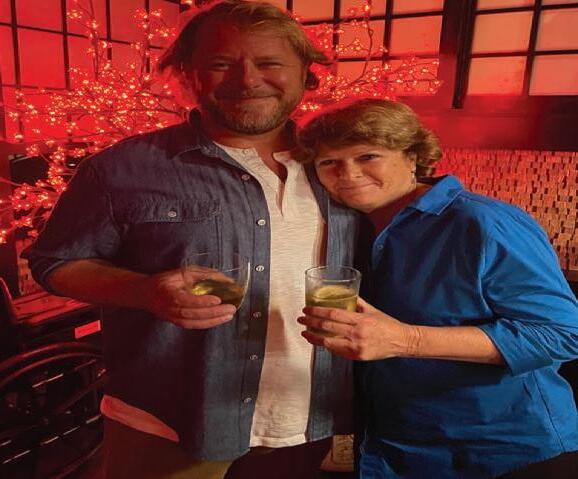

PR%F the Magazine
Michael Politz Publisher
Michele Tell Founder, Executive Director
Jennifer English Editor-At-Large
Debbie Hall Editor-in-Chief
RJ Dixon Creative Director, PR%F Awards & PR%F the Magazine
Terry Hart Director of Competitions
Colleen Banks Director of Business Development
Daniel "DD" de Anda Fast
Jena Domingue
Jerry Hammaker
Hayley Maxwell
George Manska
Louis Hansel
ESSE Design
Matthieu Joannon
Renée Korbel Quinn
Roberta Sorge
Kevin Kelly
Contributors: Contributing Photographers: Contact the Team at editor@proofawards.com
Renée Korbel Quinn
Matthew-Lorèn Lindsey
Harold Robinson
Aakash Patel
Kara Trim
Rikkia Hughes
Blake Wisz
Ali Becker, Knotted Rose Photo
Derek Richbell
Audrey Roberts


FROM THE EXECUTIVE
Dear Readers,
It’s beautiful to reflect on the past five years and to toast to our amazing readers, PR%F Awards entrants and winners, our partners, and our sponsors.
This year will mark the fifth Annual PR%F Awards spirits, wine, and beverage competition. I dedicate this moment to the talented team of staff and advisors with the vision to make it happen. Year after year, they give new and emerging brands a chance to make it in the marketplace by kickstarting their marketing endeavors. This is the opportunity to get their brands tasted by those who can buy their bottles and cans and decorate those recognized as the best with our medals and accolades.
Special thanks to Food and Beverage Magazine, Delta Sky Club®, Palms Resort Casino, the University of Nevada, Las Vegas (The William F. Harrah College of Hospitality), The NEAT Glass, and Bootleggers Distributing.
The private judges-only PR%F Awards Spirits, Wine & Beverage competition is set to be held in Las Vegas on November 7 and 8 at Palms Resort Casino in Las Vegas.
We are the definitive buyer’s competition, where beverage buyers can taste more than 1,000 new brands with new trends, new varietals, and crowning existing favorites.
We will once again work alongside William F. Harrah College of Hospitality at the University of Nevada, Las Vegas students to provide an education about spirits and wine awards.
More than 40 students will participate behind the scene learning how to create, manage and operate the world’s largest spirits competition. In addition, a group of senior students will provide a best-of-show tasting evaluation for tequila, whiskey, vodka, and wine.
We have expanded our entries to more than 300—adding more varietals of wines, extending tequilas, Ready-to-Drink (RTD), whiskey, and bourbon, along with a dedicated list of categories to the alcohol-free arena with a panel of buyers that specialize in alcohol-free purchasing.
Enter PR%F Awards, and each SKU will be automatically placed into both competitions— Masked (double-blind) an Unmasked-The Total Package (buyers/judges can see the bottle/ can, read the label, see the price point, and see your logo and brand) Enter your spirit or wine today at www.proofawards.com.
Cheers & Namaste!
Michele D. Tell Executive Director, PR%F the Magazine Founder, PR%F Awards


Alcohol-Free vs. Non-Alcoholic Explained

Booze and bubble without the hangover
By Kara TrimThe terms alcohol-free and non-alcoholic are everywhere in the media, from television shows to social media to our own PR%F AF, which launched in 2022. We set out to understand the shift that is taking place in our industry and determine if this trend is here to stay. Or is this just a fad? We conclude that it is time to pay attention
Photo by Blake WiszWhat is the actual difference between alcohol-free and non-alcoholic? The spirits industry hasn’t decided exactly how to treat these beverages. Despite the lack of clear boundaries, many people—sober, sober- curious, pregnant, religious, and those with health conditions or medications that prevent alcohol consumption—are choosing alcohol-free or non-alcoholic. Almost half (46%) of adults have purchased non-alcoholic beverages in the last year and one-quarter of Gen Z are not drinking alcohol at all. It is crucial for those in the industry to understand the difference between alcohol-free and nonalcoholic anymore.


Throughout the hospitality and bar industry, over the last nine months, there has been widespread attention and conversation about non-alcohol and alcohol-free products and readyto-drink cocktails. This mirrors a global, industry-wide increase in the intention, effort, creativity, and quality of offerings, which is a response to the booming customer demand for superior, delicious, exciting, and irresistible adult libations and choices.
Historically, the mocktails category has long been on well-developed menus, and the iconic Shirley Temple cocktail is a beloved, treasured memory from most childhoods. Virgin Mary and Virgin Pina Colada were added to the list, and drinks without alcohol were not very exciting unless you were eight years old. Today that is different, with many delicious alcohol-free and non-alcoholic beverages adding that kick without the alcohol.
alcohol-free vs, non-alcoholic explained


De Soi Champignon Dreams

Alcohol-Free
According to United States regulations, alcohol-free “may be used only on malt beverages containing no alcohol.” In practice, for beer, this typically means the brewer used fermentation prevention. In other words, the brewer withheld yeast; thus, the sugars can’t produce alcohol. Heineken 0.0 is an alcohol-free beer. For wine spirits, water is infused over a long time with the aroma of natural botanicals, flavorings, and essences to replicate the flavor profiles we are familiar with from alcoholic spirits and wine into an alcohol-free version. Seedlip products are alcohol-free spirits, and Töst Rosé is an alcohol-free dry, sparkling refresher that can be served in a wine glass and the winner of a 2022 Double Gold PR%F Award.

Non-alcoholic
The term non-alcoholic means the product “contains less than 0.5 percent (or .5%) alcohol by volume.” These beverages typically start the same way as their alcoholic counterparts and have the alcohol removed through processes such as


• Distillation: The beverage is heated to a point to evaporate ethanol since alcohol has a lower boiling point than water.
• Vacuum evaporation: This newer method uses low pressure to lower the boiling point of the beverage to preserve the flavor.
• Reverse osmosis: High pressure forces the beverage through a membrane. The membrane allows tiny particles such as water and alcohol to pass through, while the larger molecules, which include flavor and other aromas, stay behind. The concentrate is then diluted with water to get the final product.

Lyre's Aperitif Rosso
One of the biggest non-alcoholic beer brands on the market, Athletic Brewing Company, keeps its method of producing non-alcoholic beer a secret. Instead, Athletic has created a unique and proprietary system for its craft nonalcoholic beer.
Looking for non-alcoholic inspiration? Lyre’s offers delicious, non-alcoholic spirits perfect for mixing non-alcoholic cocktails (please don’t say mocktail).


Ish’s Non-alcoholic RTD Lime Daiquiri is a truly fantastic non-alcoholic version of the refreshing timeless cocktail. Also, be sure to try Noughty’s Sparkling Nonalcoholic wine, which is a favorite of New York Time’s Wirecutter.

What about halfies, blending, and zero proof? Like all adult beverages, the newest entries live on a spectrum between alcohol-free, non-alcoholic, and low-alcohol and will be explained.

Kara Trim is the CEO and founder of Choice & Co, a direct-to-consumer and wholesale non-alcoholic bottle shop specializing in irresistible nonalcoholic beverages for all drinkers.



Springtime Renewal in the Wine World
 by Jerry Hammaker
by Jerry Hammaker
Spring is a time of renewal and rebirth. It is time to shrug off the cold and dark of winter, open the windows, breathe in that fresh air, and enjoy the sun’s warmth on your face.
Simple signs of rebirth surround us. Flowers press upward through the cold ground, soon coloring our world anew in the fresh, warm breeze of the new season. Birds return to their summer homes and ready themselves for a new generation.

“Little darlin’, it’s been a long, cold, lonely winter. Little darlin’, it feels like years since it’s been here. Here comes the sun, doo-doo-doo-doo. Here comes the sun, and I say it’s alright.”— Lyrics from "Here
Comes the Sun" by George HarrisonPhoto by Matthieu Joannon
Spring challenges us with everything new. Time to put the heavy winter clothes away, do spring cleaning, and get the yard ready for summer activities. It’s time for a change and to renew ourselves.

In the wine world, vineyards warm and buds break, hailing the rebirth of the vine. Winery tasting rooms become busy with everyone from first-time tasters looking for a good time to wine experts hoping to find a new passion in a new find. New vintages are pulled from cellars as proof of the hope of previous seasons.
The change in seasons does have people changing their normal choices of wine. Many people drink more red wine in winter and start switching to whites and rosé as the weather warms. Change and renewal are already present in most wine drinkers’ seasonal patterns. But, as they are changing from red to white, they tend to choose the same white wines as they did the previous Spring.
Recently, a friend remarked that choosing a wine in a restaurant is hard. They usually choose the same wine as the time before because they were pleased with it. Another friend says they always grab the same bottle at the grocery store because they like it, and it’s easy to grab before heading to check out. Now, there is nothing wrong with enjoying a favorite wine. But, let’s think Spring. It’s the perfect time to renew, change, and challenge yourself with the prospect of choosing a new wine.
The simplest way to change your wine choices is to pick a wine from a different wine region. This way, you don’t necessarily have to give up your Chardonnay or your Cabernet to choose a new wine. If your choice of Riesling is usually from Washington State, go to Germany’s Mosel or France’s Alsace instead. If you typically grab a California Chardonnay, why not pick a Chablis from France or an Australian Chardonnay from
Margaret River or Adelaide Hills? Cabernet, you say. If you usually find yourself pulling a bottle from Napa or Bordeaux, why not try something new-to-you from Chile?
Are you feeling a bit friskier and riskier this season? Then, go for a totally different varietal as your change for Spring. If you like a crisp, white wine to pair with your fresh oysters and seafood, pick an Albarino from Spain or a Picpoul from the South of France. Malbec, Shiraz, or Syrah is an excellent alternative if

you usually drink a Cabernet Sauvignon. You can stick with a Cabernet cousin and try a Cabernet Franc instead. Viognier or Chenin Blanc would be an excellent change from your usual Chardonnay.



Don’t forget to add some color to your springtime wine selections. Grab a rosé. The next time you walk through your favorite wine shop, look for pink in shades from pale salmon to almost red. The color most always depends on how long the skins are kept in the juice. Rosé wines can be found worldwide and are made from many different varietals. So, grab a rosé made from Grenache, Syrah, Pinot Noir, Malbec, or any other bottle that piques your interest.

This is your chance. Make a change this Spring. Here comes the sun, along with your new choice of wine. I say it’s alright.


What Our Winners

have to say...

PR%F MEDALS
Best of Show

“Winning the perfect score Century Award and Best of Show in 2020 - in the middle of COVIDwas like a breath of fresh air. PR%F Awards opened big doors that were once closed for Hardy like providing an introduction for Hardy Legend 1863 to be on the shelves of Delta Airlines Delta SkyClub lounges. It was such an opportunity for our brand! ”

 Bénédicte Hardy
Brand Embassador Hardy Cognac hardycognac.fr
Bénédicte Hardy
Brand Embassador Hardy Cognac hardycognac.fr
bar gear, gadgets and beyond
Bar Gear, Gadgets and Beyond


Our experts share some of the best ones found.
Hayley Maxwell, General Manager at a Local Gaming Bar in Las Vegas; Marketing, Sales, and Buying

Hayley Maxwell works in the hospitality industry and really understands the bar business. People love gadgets, with new ones being invented, manufactured, and marketed every day for those in the food and beverage industry. Hayley is one of the experts who will share her unique perspective on gadgets.
Daniel “DD” de Anda Fast, Bar & Nightlife Consultant
Daniel “DD” de Anda Fast offers more than two decades of hospitality experience having opened more than 30 venues during that time including bars, restaurants, pool experiences, nightclubs and more. Daniel has created craft cocktail menus on the Las Vegas Strip, worked as corporate mixologist for American Beverage Ventures(ABV) and is one of a select group of lead judges for PR%F Awards.
What our experts have to say:
DD: Hayley, did you get to check out the iSi products?
Hayley: Yes! I was able to try out the soda siphon, iSi Nitro, and the gourmet stainless steel whipped cream dispenser this weekend at my bar! What did you think about the soda siphon?



DD: I found it easy to assemble and clean after use; it holds 1 liter of liquid, so that’s a good amount for an at-home cocktail or just seltzer water for people who like to add a little fizz to their water. It converts water quickly to a seltzer by adding the co2 cartridge and then pressing down on the handle.
Hayley: I agree; it’s a great product to use at your at-home bar for a quick seltzer water. You just add the co2 cartridge and twist the cover over it, and you are ready to serve. I found the bubbles from the iSi soda siphon to be soft, and it added a subtle fizz to the water, which was nice and refreshing.
The packaging for the iSi soda siphon and the other products was very classy. The directions come in all different languages, and the instructions were easy to follow to set up the device.
DD: Hayley, I know you aren’t a big coffee drinker, but what did you think of the “nitro” by iSi?
Hayley: As you explained about the soda siphon, it was easy to assemble and easy to clean, very sleek design and all stainless steel. Nitro coffee is very popular, and I tried it out at my bar and had my customers taste the product; they thought the nitro coffee was great and enjoyed watching the process of how it was made.
DD: Don’t forget you can use it for more than just nitro coffee.
Hayley: What else did you experiment with and make?
DD: Cocktails, teas, different coffees, some I made with alcohol and some I made without the alcohol. The iSi nitro adds a velvety consistency to the drinks, which is nice for a dinner party at home or an upscale restaurant.
Hayley: Oh, that is a great idea to use to mix cocktails! Maybe an espresso martini; we both know how popular that after-dinner drink is!
DD: I like that your finger doesn’t have to be on the tip to get the whipped cream out like storebought whipped cream. This iSi dispenser is much more sanitary with a handle to press down on, and the fresh cream will last up to 10 days in the fridge for that leftover piece of pie!
Hayley: What a conversation piece to have at the end of dinner! Showing your guests and family how to add the ingredients and put the cartridge in place. I know that when I see someone using it for dessert, it will be good! It’s a fun product and a great addition to your at-home bar.
DD: Another idea I tried with the iSi dispenser was to add flavoring to the freshly made whip cream.
Hayley: What did you add? How was it?
DD: I made chocolate whip cream by just adding cocoa powder to the recipe. I also tried cinnamon and peppermint. The ideas you could come up with the enhance the fresh cream are absolutely endless. Just adding the essence of a little peppermint to the whipped cream onto a slice of chocolate pie was heaven. Other ways to experiment would be by adding liquor into the mix, such as a nice bourbon, and top that on a pecan pie or even onto an after-dinner drink.
Hayley: Yum! That all sounds so delicious! I like how you stepped out of the box on these iSi products—what a great way to entertain guests at home or for specialty cocktails at an upscale restaurant. I didn’t even think of adding just a few drops of a flavor or liquor; what a great idea.
DD: Well, thank you, I have been a mixologist for a while now and have a few tricks.
Hayley: The final product from iSi is the gourmet whip stainless steel whip cream dispenser; I am actually pretty familiar with this one because my mother-in-law uses it to make fresh cream on her pies at dinner parties. Delicious! The first time I saw her use it, I was very impressed. Add in the ingredients and add the co2 cartridge, and it creates a soft cream for desserts or cocktails at home.
Hayley: The iSi soda siphon, iSi nitro, and gourmet whip stainless steel whip cream dispenser are all similar in style, and I like that once you put one together, you will be able to use all of the products. The iSi products are sanitary, simple, and make for quick preparation. Quality and freshness are what these iSi products add at home or your restaurant bar.



THE SCIENCE OF SPIRITS
Scientists have largely kept quiet while acclaimed scotch critics, authors, evaluators, and mavens swear by the salty smell of scotches aged close to the coast of Islay, Jura, Skye, and Arran. They credit salty sea air for salty aroma characteristics. Marketing again executes a twisted falsehood as science fails to push back to debunk misleading information.
TRUTH OR MYTH: Salty Aromas of Seaside Distilled Scotch
 By George Manska, CSO, CR&D, Arsilica, Inc., sensory researcher, inventor, entrepreneur
By George Manska, CSO, CR&D, Arsilica, Inc., sensory researcher, inventor, entrepreneur
The Truth: Salt has no smell.
Placing saltwater on the tongue reveals salt as a taste, not a scent. Scotch whisky distilled and barrel-aged near the coast may have been produced in an atmosphere of salt spray, but how could salt get in a sealed barrel? If salt could get in, scotch could get out, leaking or quickly evaporating (some evaporate “angel’s share”). Sorry, but salt stays outside the barrel, and scotch reviewers never discuss how salt gets in the whisky (because it doesn’t).
Was the spirit made with salty water, the barrel washed with saline water, or was salt added to the barrel? A good distiller would never do that, much less admit it.
Some Islay-grown barley is used in Islay scotch. Suppose there were salt deposits on the barley. Could it have survived processing and cleaning and the distillation
(high-temperature evaporation) process to be detectable on the tongue in the final product? All highly unlikely. Modern barley processing through soaking, screening, shuttles, and milling minimizes any possible trace of salt; only 20% of husks (popular milling mix) would have eliminated 80% of even the slight possibility of husk salt.
Seaspray (spume) is a natural product of violent waves and wind. Called SSA (sea salt aerosol), sea spray bubbles burst at the interface of water and air, rising from crashing waves, commonly leaving light salt deposits on the pier, docks, and buildings close to wave action and weather.
During severe and prolonged cold fall and winter storm conditions, sea spray travels as much as 25km within the atmospheric boundary layer. Still, jet droplets and spumes from normal wave action throughout the year travel only about

20cm above the water surface and may travel a horizontal distance of 100 feet. Seaspray consists of 60-90% DOC (dissolved organic carbon), and an additional percentage of dead algal cells, the product of algae blooms. Does any critic ever discuss the latent aromas of rotting fish and dead algae? Not that we can find. In the aftermath of most storms, subsequent rain washes salts and DOCs to the ground, and salt crystallizes. Inside sheltered storage facilities, atmosphere salt levels are extremely lower than outside.

In a tightly constructed barrel, air can slowly permeate the wood, but the probability of salt migrating through the wood membranes or tightly swollen stave seams is unlikely, if not impossible. If salt crystals reached the barrel, they would leave a tiny white line at every leaky seam. The probability is higher that microbial bacteria permeate a seam than crystallized salt.
The test:
We prepared a saline solution of .05% NaCl (table salt) as tested by a calibrated and verified salinometer. Washing the salinometer after each test, we tested several Islay scotches described as “sea salty” for salinity. They all tested 0.00% salinity. How could salt have been in the aroma if salt wasn’t in the liquid? Among four experienced tasters, none could distinguish (blind) taste or smell differences between .05% and 0.00% NaCl water.
Reviewers believe the reference to salty aromas is obligatory in notes on island/ Islay scotches due to their proximity to the sea. They know in advance what scotch
they are tasting and fear omission of ocean flavors would be considered an unforgivable oversight, as “It ought to be there.” If there were nearby sewage treatment plants or fertilizer factories, they would surely ignore that description. If there were a rose garden or pine forest nearby, they would surely describe the enticing floral and woodsy notes. Brand marketers support the myth to enhance diversification from other scotches. Perhaps the critics believe their followers will applaud their exceptional sensory prowess in salt detection when no one else can detect it. Until now, it was an unchallengeable opportunity to enhance the taster’s mystique, especially if other reviewers haven’t noted salt in the same spirit; flagrant one-upmanship, “My nose is better than yours.”
Unbiased testing:
Taste scotch double blind (no peek label/ bottle), in flights mixed with reviewed “sea salty” spirit samples. Salty air comments appear when a taster knows the brand/label/ bottle shape, or through surreptitious hints that high phenol peat smells (usually made near the ocean) are being tasted. Until “sea salty” shows up in professional sensory evaluations, it is not a proven attribute of spirits made/aged near the sea. The dead algae smell also never makes it into a bottle of scotch. So much for romantic BS.

Chief of Research and Development, Arsilica, Inc., engineer, inventor of the NEAT glass, and sensory science researcher.

Mission: Replace misinformation with scientific truth through consumer education.
Contact Information:
Phone: 702.332.7305
Email: george@arsilica.com
Business mailing address: 452 Silverado Ranch Blvd, Ste #222, Las Vegas, NV, 89183.
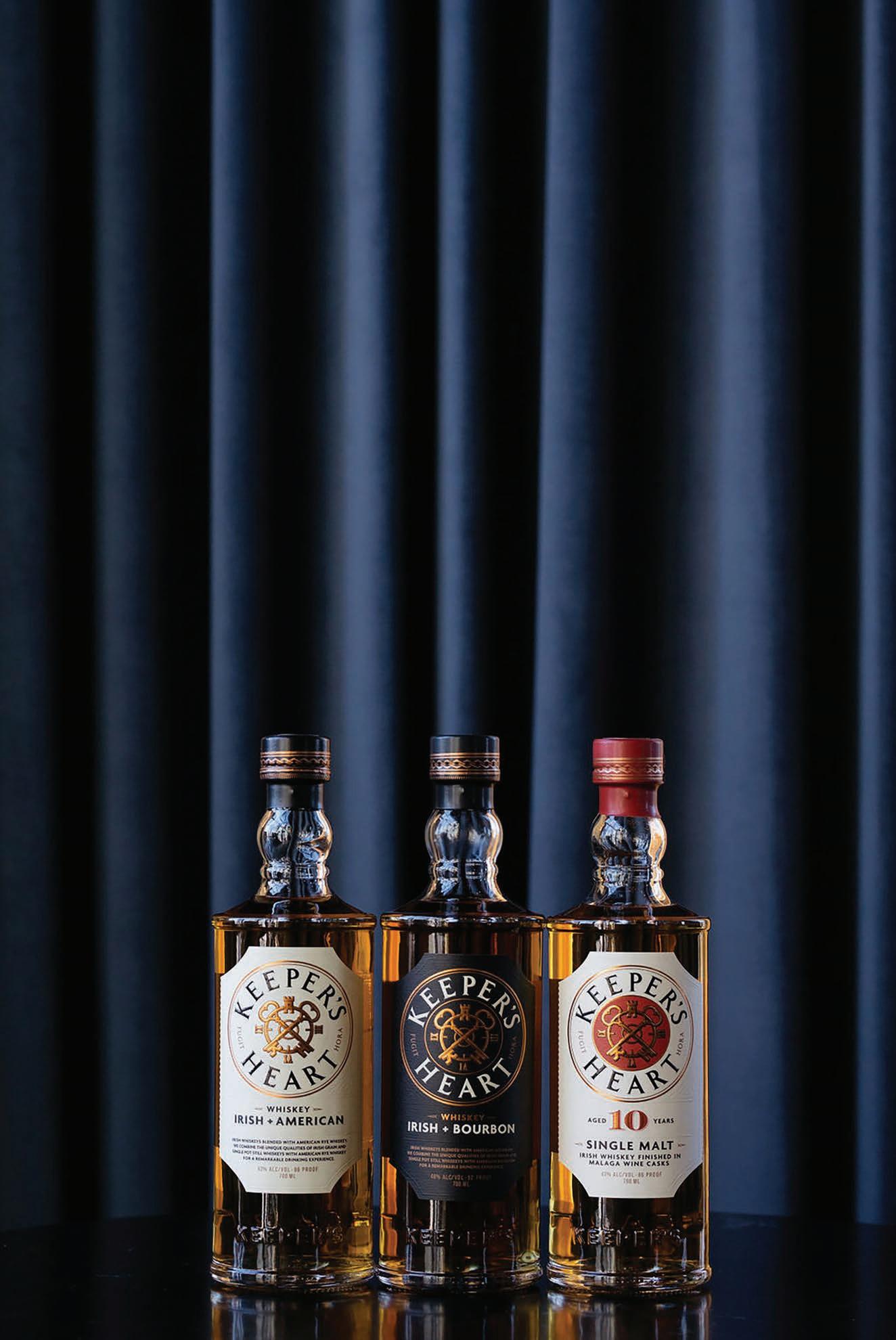




What Our Winners
have to say...
 Matt Ellenthaw, CEO & Martha Outlaw, CMO Co-Founders Barrelsmith
Matt Ellenthaw, CEO & Martha Outlaw, CMO Co-Founders Barrelsmith
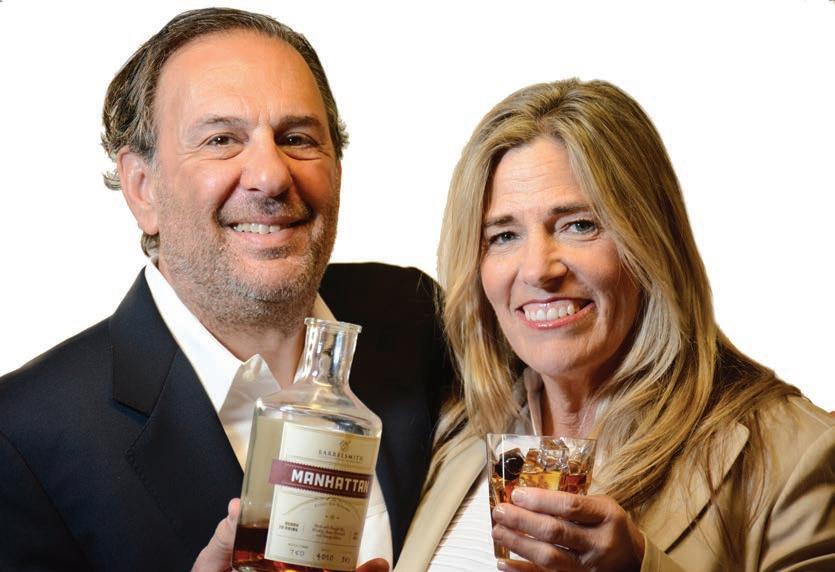

“I was thrilled to learn of our Century award from PR%F, but when I found out that 70+ of the 80 judges who are experts scored us 100 points I was truly blown away. Wow, not sure I can put in words how that makes us feel about entering this business. Pair that with the honor of being interviewed by Jennifer English. Martha and I can’t express how proud this recognition from PR%F makes us feel.”


PR%F MEDALS

BEHIND
the NUMBERS




THE CONTROVERSIAL DEBATE OVER WINE SCORES EXPLORED
By Sommelier Matthew-Lorèn Lindsey @TheLordofWine

It'sno secret the world of wine is complex and intimidating, with countless nuances and subtleties to explore. With the birth of the wine rating system over 40 years ago, we were given a formalized approach to navigate and better understand the overwhelming concept of wine quality.
We've become comfortable turning to the experts for guidance; many hold their scores sacred and final. However, this topic among wine professionals ignites the flames of debate and can be as divisive as discussing politics or religion at the Thanksgiving table.
It is widely recognized that scoring wine is an exceedingly subjective matter primarily based on personal preferences. Consequently, whether wine scores hold any true merit has been a longstanding source of contention within the professional wine community.
Some swear by the objectivity of rating systems, arguing that they offer a reliable way to assess the quality of a wine. Others reject the idea of reducing the wine to a mere number, insisting that the true value of a bottle is found in the story and context behind it. As opinions clash and tempers flare, the debate over wine scores continues to divide the community of wine lovers and connoisseurs.
Let's explore both sides of the debate.
Why Do We Score Wine?
The modern-day wine scoring system, popularized by Robert Parker Jr., serves a dual purpose in the world of wine.
It provides a straightforward and uniform method for consumers to compare and evaluate different wines based on a 100-point scoring system similar to that used in grade school. This is especially helpful to those new to the world of wine and unfamiliar with the complexities of grape varieties, winemaking techniques, and other factors that can influence a wine's flavor, quality, and price.
High scores can provide wineries with a significant advantage, as they can enhance a producer's reputation and increase demand for their wines, thereby serving as a powerful measure of prestige.
The intent is to provide a common language and a framework for assessing the quality of wines allowing us to make informed purchasing decisions.
Pros And Cons of The Traditional Scoring System(s)
The traditional scoring system for wine has both its supporters and critics in the wine industry. Supporters of the system argue that it provides an objective, standardized measure of quality that allows consumers to make informed decisions about which wines to purchase. The scores are based on predetermined criteria and are generally consistent across different reviewers and publications, making it easy for consumers to compare other wines.
On the other hand, critics of the system argue that wine is a complex and subjective product that cannot be reduced to a simple numerical score. They argue that wine is more than just a sum of its parts and that each bottle's unique character and story should be considered. In addition, they point out that the scoring system is often influenced by the reviewer's personal preferences, biases, and experience, which may not directly relate to the average consumer.
pros:
A guiding compass in a sea of wines. Wine scores provide a simple and straightforward way to evaluate a wine's overall quality.
Elevate winery reputation.
A favorable score from a respected critic or publication can provide credibility, recognition, and validation to wineries that make exceptional wines.
Confidence for collectors and investors. Wine scores can provide a useful tool for assessing the potential value of a wine over time based on how critics have scored it in the past.
Consumer confidence.
Social proof can give the buyer a sense of reassurance that they are making a good purchase. Additionally, a highly rated wine may be seen as a status symbol, further contributing to its appeal and influence on buyer confidence.
"What gets measured, gets improved" holds true. While opinions differ on the value of wine ratings, it cannot be denied that the advent of rating systems has a net-positive effect by inspiring healthy competition and a drive for innovation.
Ultimately, we all benefit from winemakers motivated to craft exceptional wines and wine enthusiasts are rewarded with the joy of experiencing complex and exciting wines that consistently perform.
cons:
While the high scores awarded by a renowned wine critic can certainly hold sway over a purchase decision, the intricacies and complexities of what makes a wine truly exceptional can often be lost in translation for the inexperienced consumer.
Understandably, the palate of a seasoned professional like James Suckling will be vastly different from that of the average wine buyer. However, James regularly tastes through thousands of wines each year, and the average wine buyer may still be swayed solely by the label design or price.
From the outside, wine scores may appear to be the pinnacle of objectivity and honesty, with critics providing elaborate tasting notes and assigning impressive ratings. However, beneath the surface lies a dirty little secret: pay-to-play.
The reality is that wineries often (not in every case) need to pay substantial amounts of money for their wines even to be considered for rating, or they must purchase costly advertising packages. This can, unfortunately, compromise the integrity of wine scores and ultimately influence the wines available to consumers.
Consumer-aggregated scores from platforms like Vivino and Wine Searcher can help discover new wines and get unbiased peer reviews. However, they often fall below the standard when it comes to providing the depth of knowledge and expertise that a trained sommelier or professional wine critic can offer. These scores and reviews may lack the formal integrity and comprehensive analysis that are hallmarks of wine industry experts' years of training and experience, which can be frustrating for consumers looking for accurate information.
Limitations of Scores
Wine scores only tell part of the story. Wine is profoundly emotional, meant to be understood viscerally, and not simply quantified. Its experience is thoughtfully designed to be all-or-nothing. We must ask what makes this wine special outside of its score.
At first sip, wine is enigmatic and shrouded in mystery, that is, until we take the time to understand the rich, evocative story it is begging to tell. We must recognize the history, culture, and tradition of that wine's journey that adds to its unique identity beyond its score.
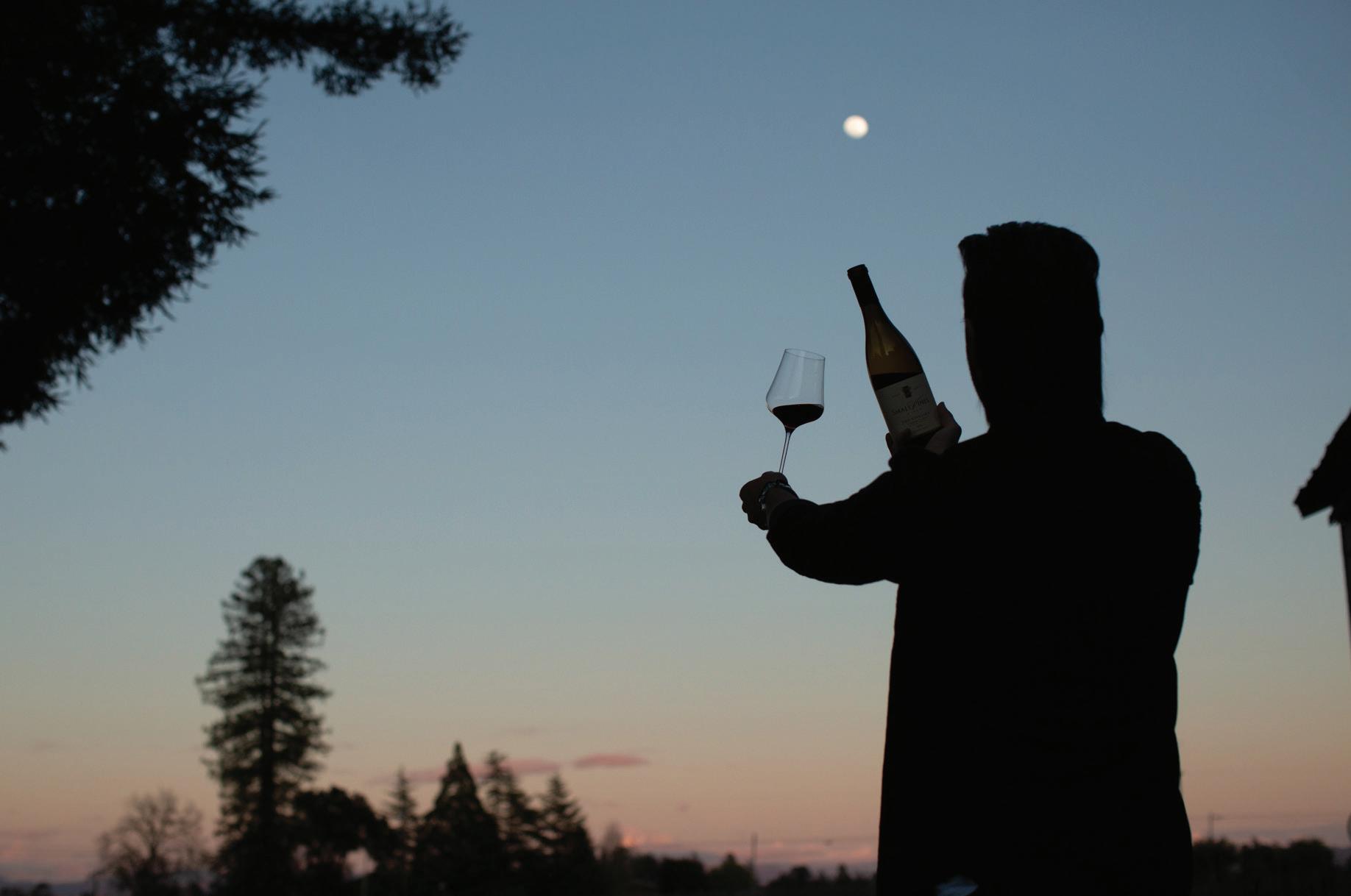
Wine scores can unintentionally set unrealistic expectations. I love the proverb: "Blessed is he who expects nothing."
While a high score may initially spark excitement and anticipation, it can also set unrealistic expectations. When we approach a wine with preconceived ideals and high expectations based on a score, we risk undermining the true magic of the experience.
Drinking in anticipation removes the romanticism of experiencing a wine for the first time with the uninhibited enthusiasm and curiosity that allows us to think about the wine critically, analytically, and objectively.
The "psychology of the score" can subconsciously influence our overall perception, misleading us to a false conclusion about the true characteristics of what's in the bottle.
The Future of Wine Scores: Modern Approaches To Scoring
There is growing evidence that scores may less influence younger consumers.
The wine industry has witnessed the emergence of a new breed of influencers in the age of social media. These influencers have amassed substantial followings and wield significant power in shaping consumer perception and industry trends ("natty" and "low-intervention" wines, to be specific).
In many ways, they represent a new response to the traditional rating systems, providing a more personalized and relatable approach to wine evaluation.
The key divergence between traditional wine reviews and the modern approach of wine influencers lies in the shift from objective evaluations of wine quality (based on rating scales). It is now a more subjective approach focused on the consumer's feelings of inclusivity and pleasure in engaging with a particular brand. Wine influencers tap into the emotional aspect of wine enjoyment, offering a more personal and relatable way of evaluating wines that speaks to consumers' experiences and desires.
Rather than telling consumers what to think or buy, wine influencers seek to connect the consumer with the wine, emphasizing the lifestyle aspects of wine and the emotional impact it can have. The informal nature of this lifestyle-based rating system is a refreshing departure from the often-elitist wine rating systems that can alienate many wine enthusiastsespecially those new to wine.
As a testament to the growing influence of wine influencers, I built and launched an influencer marketing platform for a national wine festival where I was the Executive Sommelier. I was tasked with designing the wine program for over 10,000 attendees and developing an influencer program to assist with marketing. With the abundance of wine influencers available and eager to promote our wines and events, we quickly recruited over 700 influencers nationwide. This highlights the fact that wine influencers are a powerful force in the industry and can play a significant role in promoting and shaping the perception of wine brands and events.

The Final Conclusion
Truth be told, there was a time in my wine journey when I lived and died by wine scores. It gave me a sense of security that had yet to develop. As time passed, my dependence on ratings lessened, and my capacity to form my own conclusions about wine was enriched by the wisdom that came with the cultivation of my palate.
As wine lovers, we must resist the temptation to rely solely on scores and ratings. A score is simply one of many factors to consider when evaluating a wine's quality and value.
While scores and reviews can be a useful starting point, there is no substitute for developing your palate.
Let wine scores serve as a compass for broadening your vinous horizons and be a gateway to exploring new and exciting wines. Draw on the expertise of seasoned wine writers and critics to refine your own discerning palate. But above all, keep in mind that your personal tastes and opinions are paramount. You are the ultimate authority when it comes to evaluating and appreciating the wines that bring you pleasure. In the end, your score is the only one that matters.
What is your experience with wine scores? Chime in with your thoughts: thelordofwine@gmail.com
Instagram: @TheLordofWine
Sip well.
Matthew-Lorèn Lindsey is a Sommelier with Westcoast Beverages and the owner of Appellation Wines, a luxury lifestyle company which creates bespoke wine brands. He also holds the title of Lead Judge for the PR%F Awards, the largest double-blind wine and spirit competition in the U.S.

GRANDMA’S GIN.


Joining

NOT
Ken Heck:
YOUR AVERAGE LAS VEGAS SOMMELIER AT CHINGLISH CANTONESE WINE BAR
by Harold RobinsonSince Chinglish Cantonese Wine Bar first burst onto the scene in 2020, owner Ken Heck has become an integral part of the food and beverage community, involved as a judge in multiple spirits competitions. As the restaurant’s bar and beverage program director, Ken is a sommelier, cicerone, sake, and spirits expert. He created the wine bar at Chinglish


as the framework for Chef Lam’s creations as the supporting “cast” to the “star of the show.”
“Ken has an exquisite palate,” says PR%F Awards Executive Director Michele Tell.
Every dish served in Chinglish is paired with sake, spirit, or wine with a philosophy
to complement the menu items with a drink. The wine list is less extensive than other restaurants, but each is selected to be paired with a dish. Chinglish has gentle beers, bitter beers, bold wines, light wines, sweet sakes, and light and floral sakes. The menu offers one of the most extensive spirit lists in Las Vegas.
Sommeliers are key figures in the trendiest restaurants in town, helping to amplify the overall restaurant experience. Other Chinglish sommeliers, Kitty Heck and Regina Weaver, are equally trained to guide guests to the perfect pairing for their dish. The entire Chinglish staff has extensive spirit knowledge.
Ken elevates the experience of all Chinglish guests by offering a unique evening that cannot be duplicated anywhere in Las Vegas. Ken takes the pairing experience above and beyond anything a restaurant guest has ever experienced. He has hosted many educational spirits tastings at Chinglish for wine, whiskey, and sake.
Chinglish Cantonese Wine Bar, along with Ken, truly embodies the value of heart. Guests have said that love can truly be tasted in every dish served by Chef Po Fai Lam, and Ken provides the framing for the dishes with his exquisite pairings.
Ken and Kitty Heck, along with her parents Chef Po Fai Lam and Anna Lam, are the owners and operators of Chinglish Cantonese Wine Bar in Las Vegas. Chinglish won Best of Las Vegas Gold, Best Chinese Food, and Bronze for Best Wine Bar this year. Award-winning Chef Po Fai Lam has ensured that each dish at Chinglish is cooked with the utmost elegance and refinement. His work is considered to be
the true artistry of everything that encompasses “Chinglish.”

For a personalized dining experience, fine dining lovers can find Ken at Chinglish Cantonese Wine Bar is located at 8704 W. Charleston Blvd.

For more info, visit chinglishwinebar. com and follow on Facebook and Instagram @ chinglishwinebar.










Aromatic Wine Moscato d’Asti DOCG Delights

The authentic taste can be savored in each glass.
Dogliotti began in 1870 in the small town of Castiglione Tinella with brothers Giuseppe and Marcello Dogliotti. Although their winemaking techniques were simple and artisanal, their Moscato became the apple of the winery’s eye, receiving prestigious qualifications and gold medals at essential wine competitions. When Giuseppe’s son Luigi took over the winery’s operations in 1929, he transferred their small winery to Castagnole delle Lanze. Generation after generation, the winemaking tradition of the Dogliotti family has been passed down from father to son. With time, they have refined their techniques
By Debbie Hallto create the high-quality wines they are known for today. The Dogliotti family’s passion for winemaking is found in three cousins, Erik, Ivan, and Matteo Dogliotti. With their combined enthusiasm, they have united their different talents to arrive at one common objective: to strengthen the family winery and share Dogliotti 1870 wines with the world.
Photos by ESSE DesignDogliotti is very well known for this wine with high quality, low yield grapes harvested by hand, not allowing any grapes to remain on the vine. The vineyards are located about 1,200 to 1,500 feet in elevation, with differences in temperature. During the night, the grape can “rest,” and during the day is exposed to the sun. This creates a wonderful balance between sugar and acidity, so Moscato d’Asti is a naturally sweet wine with no added sugar, only natural sweetness.
“Certain criteria and procedures must be followed to produce this wine,” explains Eros Spinozzi, selector of wines (Portfolio owner) for R.S. Lipman Company, his exclusive importer for the United States. “It is a wine that is one of the most famous Moscato from this region.”
“Sometimes Moscato wines do not offer the acidity so that they can taste too sweet,” explains Eros. “The sweetness of this wine is not overpowering, and the taste is very refreshing. Acidity is an essential aspect for sweet wines.”
Dogliotti Moscato d’Asti also ages well and can be stored (correctly) for four to five years. However, Eros admits that most people want to enjoy Moscato when it is first bottled and distributed to enjoy its unique boutique and fresh taste.
“I have tried many moscatos, and this one represented authenticity for the region,” says Eros. “This wine has its own identity where you can taste the grapes grown for this wine, the weather, the soil, the temperature, and the territory.”
“I selected this wine and the winery because I like to work with wineries that do not outsource grapes or outsource its wine to finish its production. I work with wineries with full control of their vineyards. Their wine is very authentic, and their standard of quality is always high.” The region is important to Italian winemaking.
The aromatic wine Dogliotti Moscato d’Asti can be only produced in 52 villages in the southern part of Piedmont, within Asti, Alessandria e Cu-

We look for the stories and the background of the wines we represent ... we offer wines with hundreds of years of history with real people. American consumers love to hear about the history of wine. We are proud guardians of our traditions."
neo. It is produced from Moscato Bianco grapes and is known for its surprising perfume-like fragrance, light body, semi-sparkling, and spritzy character. It also offers lower alcohol content (about 5-8% ABV) and its dazzling fruit-forward palate profile with a sweet welcoming factor. The wine’s color steers towards straw yellow with occasional tinges of gold. Moscato’s inherent aromatics are stunning—orange blossom, honeysuckle, almonds, ginger, and fruit dominated by green grapes, citrus tones, and ripe peach nuances. On the palate, expect an impressive lineup of fresh, forward fruit with sugar levels ranging from semi-sweet to sweet. The wine is wrapped in medium acidity from pear and apple to orange and lime, with consistent appearances in the ripe, juicy peach and apricot category. Moscato’s flavors are extraordinarily fruit-filled. The delicate cascade of bubbles, light body, and sweet surprise culminate
to woo and win many unsuspecting palates to the wide world of wine.

Eros’s family started with wine in the early 1970s. His uncle introduced fine Italian wine to the U.S. market when most Americans were only familiar with Chianti wine with a straw covering. Eros’ background includes attending the Culinary Institute of Italy, and his career has always included food and wine. He joined his uncle in the business 30 years ago and has been operating the business since his uncle’s passing in 2005. Their market includes high-end restaurants and upscale wine shops.
“We look for the stories and the background of the wines we represent. The wine business is an item we sell, but we offer wines with hundreds of years of history with real people. American consumers love to hear about the history of wine. We are proud guardians of our

traditions. We love it when people experience different wines,” states Eros. “The wine world is becoming standardized, and we encourage people to open their minds, support the regional wine-makers, and not just settle on the mass-produced wines.”
For more information, visit erosspinozziselections.com, follow on Instagram @ rslipmanco, and @ rslipman
Denomination: Moscato d’Asti DOCG

Grape variety: 100 % Moscato Bianco
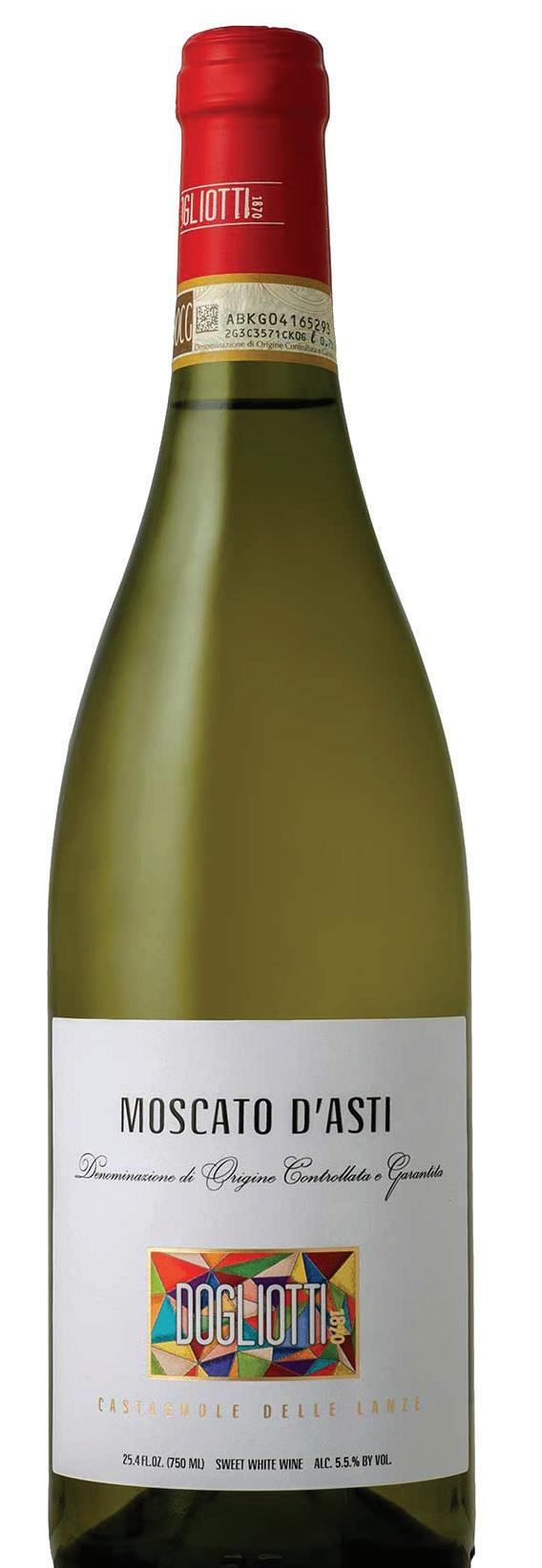
Vine-training system: Guyot
Soil: Clayey-calcareous, calcareoussiliceous
Grape-harvest: Mid-August to early September
Max. Crop/hectare: 10 metric tons
Yield in wine: 75%
Alcohol percentage: 5,5 % Vol
Color: Golden straw color
Perfume: Orange blossom, honeysuckle, almonds, ginger and fruit dominated by green grapes, citrus tones and ripe peach nuance
Taste: From pear and apple, to orange and lime with consistent appearances in the ripe, juicy peach and apricot category
Food match: Fruit-based desserts, ice creams, holiday desserts, and ideal to prepare cocktails
The delicate cascade of bubbles, light body, and sweet surprise culminate to woo and win many unsuspecting palates to this lovely Italian moscato. A 150 year tradition, Dogliotti 1870
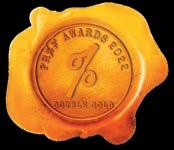

www.erosspinozziselections.com
@dogliottiusa #dogliotti1870



UNLVino Announces Lineup with Celebrated Grand Tasting as Finale
 Photos of 2022 UNLVino by Ali Becker @knottedrosephoto
Photos of 2022 UNLVino by Ali Becker @knottedrosephoto
ino returns, in partnership with Southern Glazer’s Wine, Spirits & Beer of Nevada and the William F. Harrah College of Hospitality, with the 49th Annual UNLVino Food and Wine Festival.

UNLVino continues its unique twist on the special event with “UNLVino Presents,” an epicurean experience designed to take taste buds on a culinary journey.
UNLVino Presents expanded its Bon Vivant Dining Series to include immersive dining experiences. Chef Hunter Fieri, UNLV Executive Chef Mark Sandoval, and hospitality students will host the final dinner at the University of Nevada, Las Vegas. The dinner and wine pairing on April 20 will feature a four-course meal plated for 40 inside Hospitality Hall featuring wine pairings from Chef Fieri’s winery, Hunt and Ryde.
Entering its 49th year, UNLVino’s The Grand Tasting returns on April 28 from 6 to 9 p.m. with a guest list limited to 500 attendees. The flagship event will continue its elevated, more exclusive experience before ramping up for a historic bash in its 50th year. UNLVino continues to bring together the best chefs, distillers, winemakers, and brew masters from around the globe designed to create new opportunities for university students. The event, developed
by university alumni in 1974, has raised millions of dollars to fund scholarships for the students of UNLV William F. Harrah College of Hospitality. It remains one of the longest traditions at UNLV.
The UNLV Harrah College of Hospitality is consistently ranked as one of the top hospitality programs in the world. Studying just blocks away from the epicenter of the entertainment capital of the world, the Las Vegas Strip. UNLV hospitality students enjoy unparalleled access to hands-on, industry-relevant experience. Each year the college organizes nearly 600 internships, welcomes more than 100 national hospitality brands to recruitment events, and pairs industry mentors with students.
To purchase tickets and more information, visit unlvino.com. Follow on @ UNLVINO49 and @ unlvhospitality.

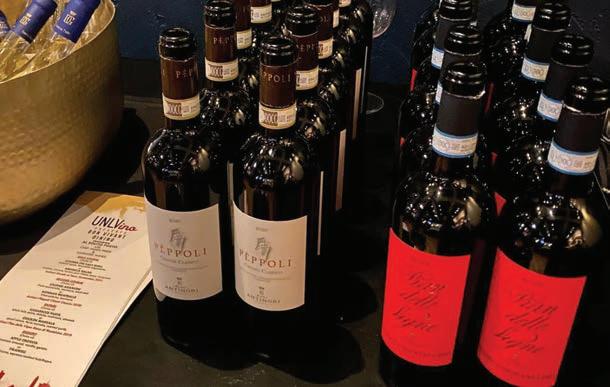

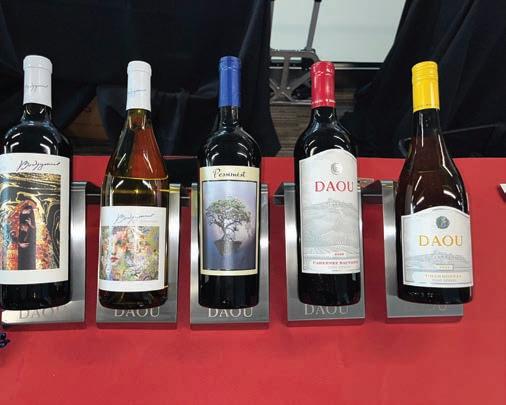


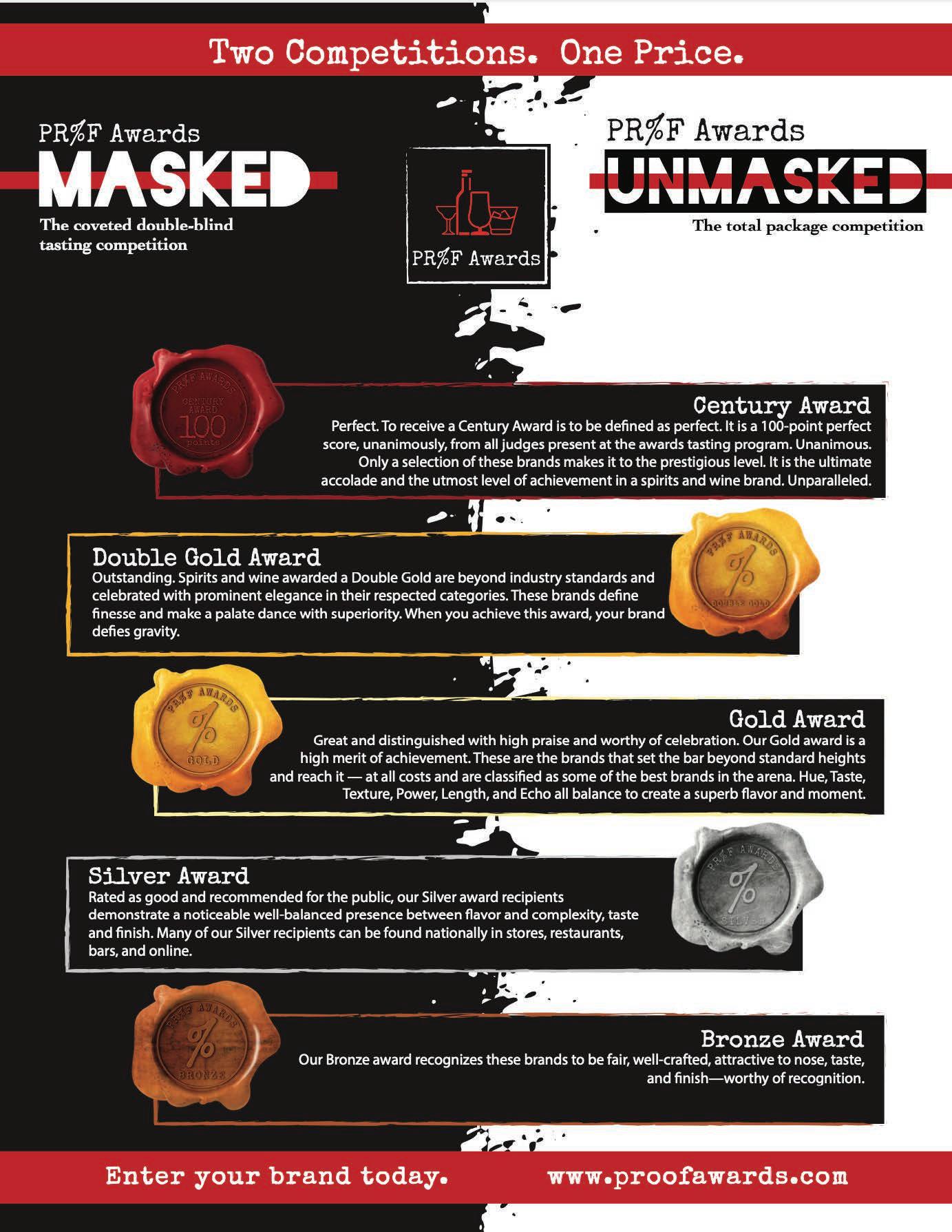
 by Aakash Patel @nycaakash @mezcalhotel
by Aakash Patel @nycaakash @mezcalhotel
In 2020, I founded the Mezcal Hotel, a phygital (physical plus digital) community that celebrates the culture, traditions, rituals and ceremonies of agave by creating immersive experiences that educate and inspire. Agave spirits are deeply ingrained in Mexican culture and tradition, and their popularity has helped to bring attention to the rich history and heritage of this region. This cultural significance has helped to make them more appealing to consumers who are interested in learning about different cultures.
Agave spirits like tequila and mezcal have a unique and complex flavor profile that sets them apart from other spirits like vodka or whiskey. This taste is a result of the agave plant's natural sweetness and the way it's processed during production. Mezcal has a distinctive smoky flavor that sets it apart from other spirits like tequila. This flavor is due to the way it's made, which involves roasting the agave plant before fermenting and distilling it.
Agave is a highly sustainable crop that requires minimal water and can grow in arid regions where other crops would struggle. Additionally, agave can be harvested over the course of several years, which helps to reduce soil erosion and preserve natural resources. “Art of Agave will feature stories that showcase the past, present and future of what makes agave special.
Agave has been a significant plant in the culture and history of Mexico for thousands of years. It has been used for making food, beverages, medicine, and various household items.

Agave spirits, such as tequila and mezcal, are widely considered to be some of the most luxurious and special alcoholic beverages in the world. From their unique flavor profiles to their cultural significance, there are many reasons why agave spirits are highly prized by enthusiasts and connoisseurs alike.


One of the main reasons that agave spirits are considered luxurious is their rarity. Agave plants take several years to mature, and once harvested, they cannot be used again. This means that the production of agave-based spirits is limited, with only a certain amount of bottles available each year. Some highend tequila and mezcal brands even produce their spirits in small batches, making them highly exclusive and sought-after.

Agave spirits are special because of their cultural significance. These spirits have been an important part of Mexican culture for thousands of years, with tequila and mezcal being deeply tied to the history and traditions of the country. Drinking agave spirits can be a way to celebrate and honor this rich heritage, adding to their appeal and perceived value.
Agave spirits are also considered luxurious because of the experiences and memories associated with drinking them. Sipping a high-quality tequila or mezcal can be a special and memorable occasion, whether enjoyed with friends or sipped solo. Many of these spirits are served in elegant glassware and are often paired with food, adding to the overall luxurious experience.


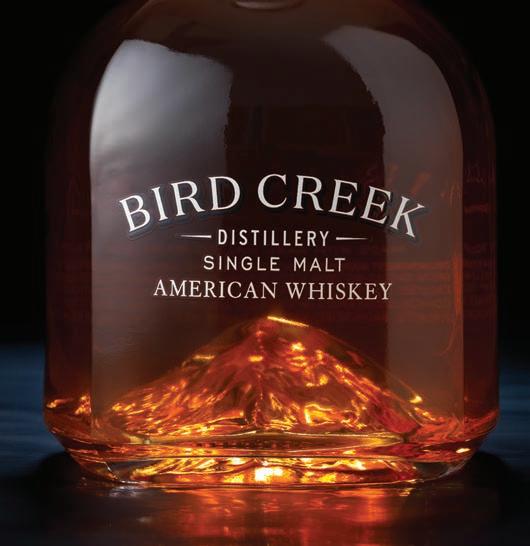


The Color of Wine by UrbanVino
By Jena Domingue Creator and CEO of UrbanVino House of Brands
The McBride sisters are two highly successful and influential women in the world of wine. Andrea and Robin McBride were born and raised on opposite sides of the world, but their passion for wine brought them together to create one of the most successful wine businesses in the United States.

Andrea and Robin were both born into different families in different countries. Andrea was born in California to an African American mother and a New Zealand father. Robin was born and raised in Marlborough, New Zealand, by her mother, who was of Maori descent, and her Irish father. Despite growing up in different cultures, they shared a love of wine that would eventually bring them together.
The McBride sisters met when they were in their 20s when they discovered they shared the same father. They quickly bonded over their shared love of wine and decided to start a business together. In 2005, they founded the McBride Sisters Collection, a wine company producing high-quality wines from California and New Zealand.
Their company has been wildly successful, with their wines now sold in more than 50 countries worldwide. The McBride Sisters Collection includes a variety of wines, from sparkling wines to rosés to bold reds. They use sustainable and eco-friendly practices in their vineyards, making them successful and environmentally conscious.

But the McBride sisters are more than just successful businesswomen. They are also advocates for diversity and inclusion in the wine industry. Historically, the wine industry has been dominated by white men, and the McBride sisters have been working to change that. They are vocal about their mission to create a more inclusive and diverse industry, and they have created programs to help women and people of color enter the wine industry.
In 2019, the McBride sisters launched the SHE CAN Professional Development Fund, which provides financial support to women in the wine industry who are
seeking to advance their careers. The program offers scholarships, mentorship, and other resources to help women break through the barriers that have historically kept them out of leadership roles in the wine industry.
The McBride sisters have also been vocal about the need to recognize and celebrate the contributions of women and people of color to the wine industry. In 2020, they launched the Black Girl Magic Wine Scholarship, which awards scholarships to women of color pursuing a career in wine. The scholarship is intended to help women overcome the financial barriers that can prevent them from pursuing their dreams in the wine industry.
The McBride sisters have been recognized for their contributions to the wine industry
and their commitment to diversity and inclusion. They have been featured in a variety of publications, including Forbes, Wine Spectator, and The New York Times. They have also received numerous awards, including the Wine Enthusiast's Wine Star Award for Wine Entrepreneurs of the Year in 2019.
The McBride sisters are not only successful entrepreneurs and advocates for diversity and inclusion, but they are also an inspiration to women everywhere. They have shown that anything is possible with hard work, determination, and a passion for what you do. They are proof that barriers can be broken and that the wine industry, and any industry, can be more inclusive and diverse.

For more information about the McBride sisters, visit mcbridesisters. com/Black-Girl-Magic. Follow on Facebook @ mcbridesisters, Instagram @ mcbridesisters, and Twitter @ mcbridesisters.
Visit UrbanVino.com or Apple Podcasts to listen to the UrbanVino Podcast, and visit YouTube for the video version. Connect with Jena on LinkedIn @ Jena Domingue and Instagram @ urbanvino.
jena@urbanvino.com
is the creator and

Sales and Talent and

at WineDirect. She is also US Ambassador (California) for Liquid Icons, a global agency working with ultra-premium wine brands worldwide, offering scholarships and apprenticeships specifically geared to promote diversity and inclusion in wine education and hospitality.


PURE, PREMIUM MIXER for your TOP SHELF SPIRITS

Spirited Inspiration
By Renée Korbel QuinnFort Lauderdale Whiskey Society

As a member, I recently had the unique opportunity to help select our most recent Charity Barrel, a Maker’s Mark Private Selection. Bob explains how their Private Selection Barrel is created by adding 10 custom wood finishing staves to each barrel which is then aged in their limestone cellar to extract a unique, flavorful taste profile. The finishing staves can be any combination of five flavor profiles chosen especially for this program. From a possible 1,001 possible stave combinations, our team selected which of those staves, and how many of each, were added to the barrel to create the unique flavor profile for this barrel. Our selection team consisted of several of our founding members, who have selected well over 100 barrels over the years, as well as several members at large who were selected in a drawing, the proceeds of which were also donated to the charity.

We have been fortunate to have worked with many different venues in South Florida over the years for our member events as well as for our charity events, including Stache Drinking Den, The Brass Tap/Unit B and Chops and Hops. We began working with the ownership at Batch New Southern Kitchen after their venue opening. They have a great whiskey selection, and fantastic food, in a fun and vibrant atmosphere. They are also a fantastic partner in our charitable endeavors. In fact, the charity for this particular barrel was selected by the ownership at Batch.
Made Man Bob
The Fort Lauderdale Whiskey Society is a group of over 3,300 enthusiasts and industry professionals dedicated to appreciating fine whiskey in all its forms (Bourbon, Scotch, Canadian, Irish, and




Japanese). Through tastings, whiskey dinners, whiskey events and discussions on our Facebook group page, we seek to expand the knowledge of both our members and the public on our favorite beverage. The society is open to everyone, from beginners to experts, and all are welcome to join our community. We have regular monthly meet-up tastings where anyone can attend and learn more about whiskey and meet like-minded individuals. In addition to working with the other founding members of the Society, I’m also a producer and on-air host of a radio show and podcast about whiskey called Sips, Suds and Smokes.
I have a good number of friends in the whiskey business. I thought that perhaps we could leverage those contacts, along


with our Society member’s love of whiskey, for a charitable purpose. So a few years ago, I partnered with a distillery and a local retailer, where we went to Kentucky to select a private barrel of whiskey. That barrel was then bottled and sent to the local retailer, who agreed to handle the receipt and sale of the bottles and donate the profits from that barrel to our main charity, Honor Flight South Florida. It’s a win for everyone! So we have raised over $20,000 and hope to add to that tally with this Maker’s Mark barrel selected for our friends at Batch New Southern Kitchen. This year, we hope to continue our charitable work with our partners to increase the number of charity barrels and other whiskey-themed events, so we can continue supporting the fine work these charities provide. ”

Sips, Suds and Smokes Accolades


Winner – 2021 Taste Awards
Best Food or Drink Radio Broadcast
2022 Taste Awards Hall of Fame Inductee
2021 Webby Award Honoree –Arts and Culture Podcast
Winner of the 2019 iHeart Radio Podcast Awards – Best Food Podcast
Gold Medal Winner 2019 Barleycorn Awards - The Society of Spirits Writers & MarketersBest Podcast

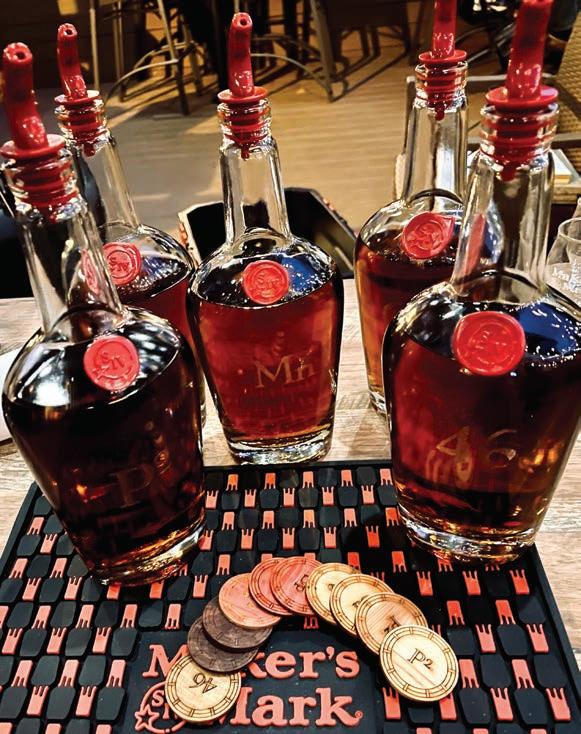
Facebook @ SipsSudsSmokes
Twitter @ sipssudssmoke
Instagram @ made_man_bob
Charity Partner


PATCHES stands for Pediatric Alternative Treatment, Care, Housing & Evaluation Services, Inc., while PPEC means Prescribed Pediatric Extended Care. They help children who need nursing care every day and cannot have their needs met in daycare or school, children who need nursing care every day but do not need to be in a hospital, and children who have been hospitalized or have had frequent emergency room visits for an ongoing or unresolved illness. Children in non-acute care settings have a number of distinctive care needs, such as growth and developmental issues, often complicated by their medical fragility. PATCHES goal is to help each child reach his or her potential safely in a fun-filled caring environment. They provide a comprehensive team of multiple healthcare professionals to monitor the child’s condition throughout the day and work to develop a plan of care, especially for each child. They offer a variety of medical treatments, therapy treatments and special support to assist our patients and their families, offering parents the peace of mind brought about by a program staffed by healthcare professionals who are expertly trained in the care of children with both sub-acute and chronic conditions. Their center is fully equipped and staffed to accommodate children who require the support of ventilators, tracheotomies,
oxygen therapy, feeding tubes or who have other special medical needs. Supportive therapies, respiratory care, educational programming, and door-to-door transportation are also available. All funds raised by this charity barrel collaboration will support this organization’s work with the children.
Renée Korbel Quinn Spirited South FloridaA Taste of History
Peltier Winery & Vineyards produces great wine and sustains the land.
Peltier Winery & Vineyards, established in 2001, from its origins to the quality of its wine, keeps farming as its foundation.
Third-generation Lodi, California grower, Rod Schatz, always had an instinct for farming and an entrepreneurial spirit. From a young age, Rod's dream was to own vineyards and farm his way.
The day came in 1985.
After graduating from California Polytechnic State University and marrying his wife and co-proprietor,
Gayla, the pair bought their first piece of land. It was 40 acres of Old Vine Zinfandel in the heart of the Lodi Appellation, where the winery sits today.
Rod spent the next 15 years growing his custom harvest business. He bought more vineyards and mechanical harvesters, managed vineyard crews, and slept most harvest nights in the back of his pickup. All the while, Rod was gaining a reputation for growing high-quality grapes. Then came the year when there was a surplus of grapes that were not sold. This occurred when the boutique winery market was growing in Lodi, and Rod and

Gayla saw an opportunity. In 2001, they built a custom crush facility where their grapes could be processed and sold as bulk wine. This ensured that fruit would never be left hanging, and the quality maintained in the vineyard would carry through to the bulk wine.

A particularly good Petite Sirah was produced in 2005 and inspired the notion that they could produce wine under their own label. At the California State Fair, Peltier Petite Sirah won Best of Class and Best of Region. They've been making exceptional wines ever since and farming over 1,000 acres of Estate Grown grapes in the Lodi Appellation, producing multiple brands and maintaining the quality.
All of its 1,000 acres are farmed sustainably according to Lodi Rules, a third-party certified program created for the Lodi Appellation by a committee of scientists, growers, wildlife biologist, and farm advisors. These are stringent rules that they currently farm by and have been farming by since their greatgrandparents began growing wine grapes. It is the care for the land, air, water, habitat, and employee, with a long-term vision focusing on farming for the future of the land. They were one of the first growers to receive certification for all of their Estate Grown Vineyards.
"For us, sustainability isn't only about honoring what's best for the environment; it's what's necessary to adapt to an everchanging industry and to create a brighter future for generations to come," explains Faryn Schatz, Marketing Manager of Peltier and daughter of the proprietors, Rod and Gayla. “We continuously search for better, more practical ways of producing highquality wine and aren’t afraid to try a new process or idea, like our worm farm.”
THE WORM FARM is an energyefficient way to treat its process water for reuse in the vineyard. This system is a 3,000-square-foot box full of wood shavings and California Red Worms. Process water is pumped over the top of the system on an as-needed basis, and as gravity pulls it down, the worms wiggle around, eating microbes and aerating the system. What comes out is high-quality, regenerated water, free of 99% of wastewater contaminants for reuse in the vineyard. The process takes just four days instead of the two weeks it takes traditional systems, and they can use 95% less energy.
The list of wines includes:
Peltier Estate Vermentino
The 2021 Vermentino was sent to Cagliari, the capital of the Italian island of Sardinia, where about half of the world's Vermentino is grown, to the second Vermentino International Wine Concourse. That wine was awarded the Grand Gold Medal with 95 points and a Top 5 ranking from the competition. Peltier’s
Picked early for low alcohol, low sugar, and high acidity, Peltier’s Vermentino is incredibly aromatic, refreshing and requires minimal winemaking intervention.

"It was intriguing to take a chance on a lesserknown varietal when they planted it to see what they could do. They're always trying to innovate and differentiate themselves. The thing about taking a risk is that whether the outcome is what you want or not, you learn something. They knew its Vermentino was good; this award tells the rest of the world," explains Faryn.
Nose: Fresh Quince | Meyer Lemon | Green Apple
Flavor: D’anjou Pear | Crenshaw Melon | Minerality |
Lemongrass
Color: Light Straw
Mouthfeel: Crisp | Fresh
Acidity: High
Body: Light
Finish: Juicy | Crisp | Invigorating
RS: 0.24 g/L
ABV: 12.5%
The Gala Sparkling Rosé Wine - Brut Nature
The approach of a milestone birthday celebration for Peltier’s proprietors became the perfect occasion to produce their very first sparkling wine. Made in the Méthode Champenoise, where the last stage of fermentation happens in the bottle, this wine is 50/50 Chardonnay and Pinot Noir. A delicate mouthfeel builds in the middle with bubbles and is meant as much for a special occasion as a Tuesday night because life should be filled with lavish moments!
Nose: Stone Fruit | Nectarine | Peach | Apricot |
Pear
Flavor: Nectarine |Pineapple | Green Apple
Color: Pale Copper
Mouthfeel: Delicate | Mid-Palate builds with bubbles | Silky
Acidity: Medium/High
Body: Round
Finish: Dry | Silky | Long, Fruit Finish
RS: 0.2 g/l
ABV: 12%
Schatz Family Reserve Cabernet
Sauvignon - Barrel Select
This reserve Cabernet is the epitome of exceptional winemaking. The natural characteristics of the varietal and vineyard personality shine and are elevated by 18 months spent in New French Oak Barrels. Rich tannins associated with Cabernet are present yet softened and barrel selection was based on the most fruit forward and aromatic qualities.
Nose: Black Currant | Plum | Blueberry | Roasted
Coffee | Dark Chocolate
Flavor: Blueberry | Dark Roasted Coffee | Dark
Chocolate | Vanilla
Color: Deep Purple
Tannin: High Tannins
Mouthfeel: Lush
Acidity: Medium
Body: Full
Finish: Dark Chocolate-Covered Coffee Beans
RS: .58 g/L
ABV: 14.5%
There is a tasting room with a guided experience from its friendly hosts or self-exploration; the options are abundant, with 24 wines, and open daily.
The Peltier Diamond Wine Club offers everyone the opportunity to join with no fee, only payment of the cost of the wine, plus tax and shipping if applicable. Wines are fully customizable, with discounts, events, and other benefits.

The Schatzs have always been forward-thinking, advocates for California growers, and dedicated to helping others. As a past Chairman of the California Association of Winegrape Growers and President of the Lodi Winegrape Commission, Rod has promoted the California winegrape growing industry locally and nationwide. The success and improvement of California agriculture will forever be a driving force in Rodney's life. Gayla has dedicated much of her life to the community as a past member and president of Children's Home of Stockton and a long-time American Cancer Society volunteer.
"As farmers first, we’ll always focus on quality in the vineyard. It's what allows the natural characteristics of a varietal and the vineyard personality to show, it’s what makes us unique. Peltier Wines are made for those times spent with friends and family lingering over a good meal and we hope that everyone who opens a bottle feels welcome at our table.” says Faryn.
Peltier Winery & Vineyards
22150 N. Kennefick Road
Acampo, California 95220
peltierwinery.com
Facebook @ peltierwinery

What Our Winners

have to say...
Adam von Gootkin Co-Founder/CEO Highclere Castle Gin
Highclere Castle Gin
HighclereCastleGin.com

“With our having received so many awards from the team at PR%F, it’s obvious this panel of experts are true spirit a cionados.
Highclere Castle Gin is well on its way to becoming the most awarded gin in the world due to PR%F’s commitment to recognizing authentic, well produced brands.”

 PR%F MEDALS
PR%F MEDALS
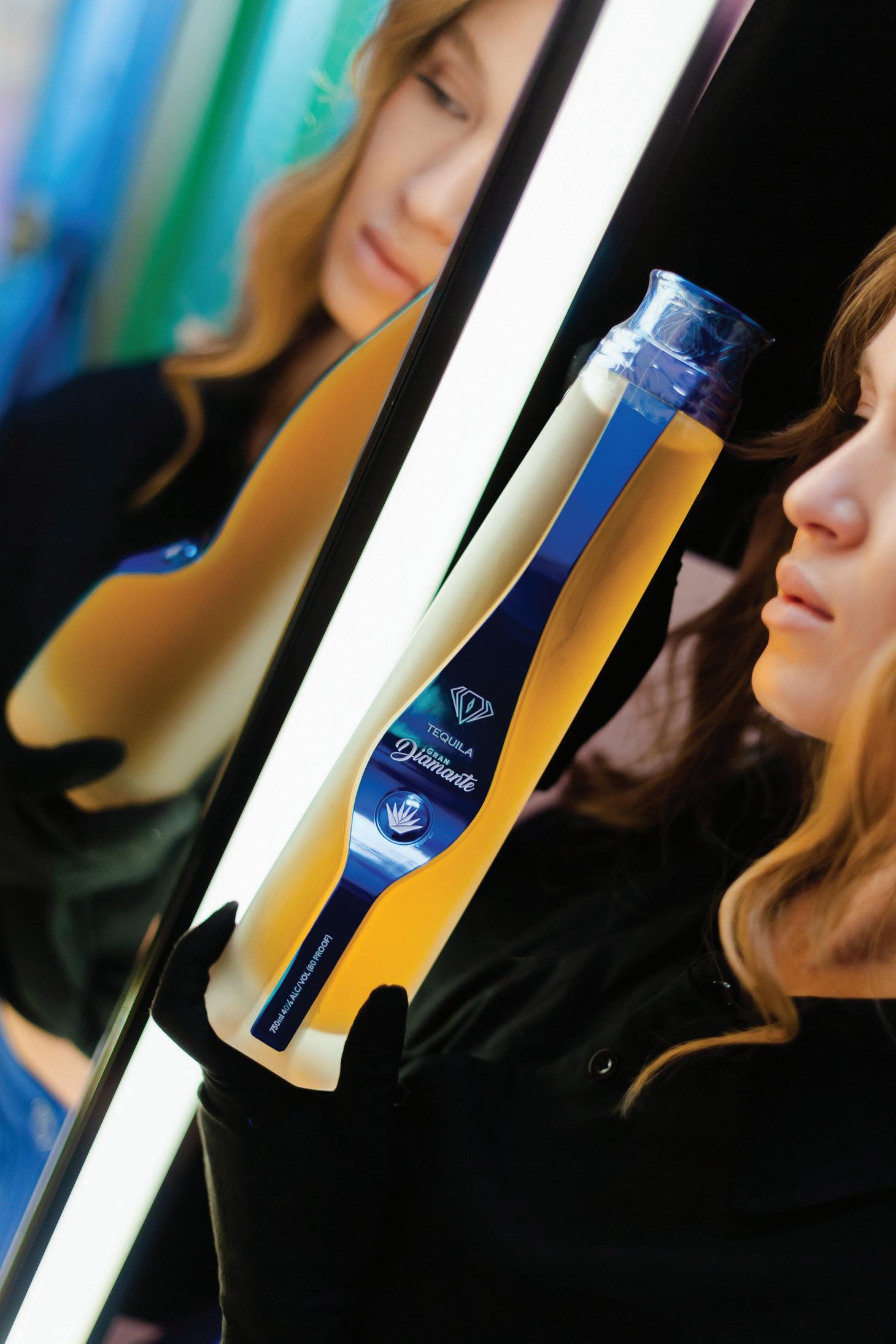
Mastering Wine
Montepulciano d’Abruzzo showcases wine in Las Vegas
Recently, Montepulciano
d’Abruzzo held a wine tasting and Master Class in The Four Seasons in Las Vegas. Montepulciano d’Abruzzo became one of Italy’s most widely exported DOC wines starting in the late 20th century and continuing into this year.
The Consorzio Vini d’Abruzzo experience featured first-hand the wonders of the Abruzzo region. The esteemed Master Sommelier Brandon Tebbe and Abruzzo Consortium Brand Ambassador Davide Acerra presented the signature Montepulciano grapes during the educational and fun Master Class and Guided Tasting.
Abruzzo is one of Italy’s best-kept secrets. It is a diverse region offering unspoiled breathtaking landscapes and quaint villages rich in history and rapidly receiving worldwide attention for its beauty and uniqueness.
By Debbie HallThe Consorzio di Tutela dei Vini d’Abruzzo (Consortium for the Protection of Wines of Abruzzo) is a nonprofit association comprised of all the entities forming part of the control system, which aims to
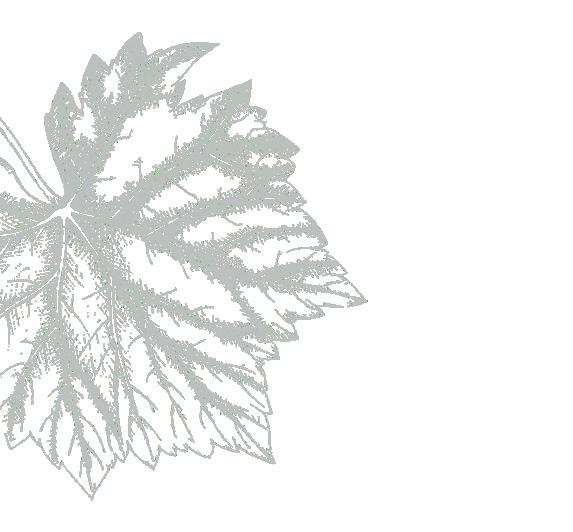
protect, enhance and take care of the interests relating to the controlled designations of origin of the regional territory. Attendees tasted and learned about the characteristics of one of their esteemed wine designations Montepulciano d’Abruzzo. This is an inviting intense red wine with a characteristic ruby red color, the unmistakable fragrance of red fruits, flowers, and spices—the dry, soft, and moderately tannic flavor.

Montepulciano d’Abruzzo is produced from the Montepulciano wine grape in the Abruzzo region of Italy’s central/eastern region. The DOC region covers a vast expanse of land between the Apennines foothills down to the Adriatic coast.




One of Italy’s most mountainous regions, over 65% reach up to 9,000 feet above sea level. The hillside vineyards, especially in the northern areas, are planted on calcareous clay benefitting from sun exposure and ventilated y dry breezes from the Adriatic Sea.
Several subzones are defined in the DOC rules delineating small areas that produce higher-quality wines with stricter requirements. These are Casauria, Teate, Alto Tirino, Terre dei Peligni, and Terre dei Vestini.

Montepulciano is produced in all four provinces of Abruzzo—Pescara, L’Aquila, Chieti, and Teramo—since the fertile southern province of Chieti produces the most extensive total quantity of wine. In the countryside of Atri, which produced a wine called Hadrianum, the first bottle of Montepulciano was labeled.
The mountainous province of L’Aquila is noted mainly for the dry Rosato wine was labeled Cerasuolo as a separate DOC. Other vineyards are planted in the northern provinces of Pescara and Teramo (a separate DOCG designation). These Northern provinces feature less fertile soils with more ferrous clay and limestone at higher elevations. This creates cooler microclimates that tend to produce wines that are more concentrated.
For more info, visit vinidabruzzo. it/en and follow on Facebook and Instagram @ vinidabruzzo.

What Our Winners

have to say...
Anna Scott Owner/Founder Anna’s Kitchen Shrub annaskitchenshrub.com

“The PR%F Awards is a true competition designed to elevate worthy brands. The professionalism of the organizers and the extensive exposure of my brand has far exceeded my expectations.”

PR%F MEDALS


CELEBRATE!
The PR%F Awards

Great spirits flowed together in camaraderie and unique tastings when spirit industry leaders gathered to judge the PR%F Awards 2022, 2021, 2020, and 2019. Officially named the world’s largest spirits and wine competition in the US, PR%F Awards encompassed innovation with judging. PR%F Awards 2021 launched a new dual adult beverage competition format including two competitions in one—PR%F Awards-Masked, The DoubleBlind Tasting, and PR%F Awards-Unmasked, The Total Package. It has been four years of incredible tastings, new partnerships and the fun of Las Vegas with more to come.



